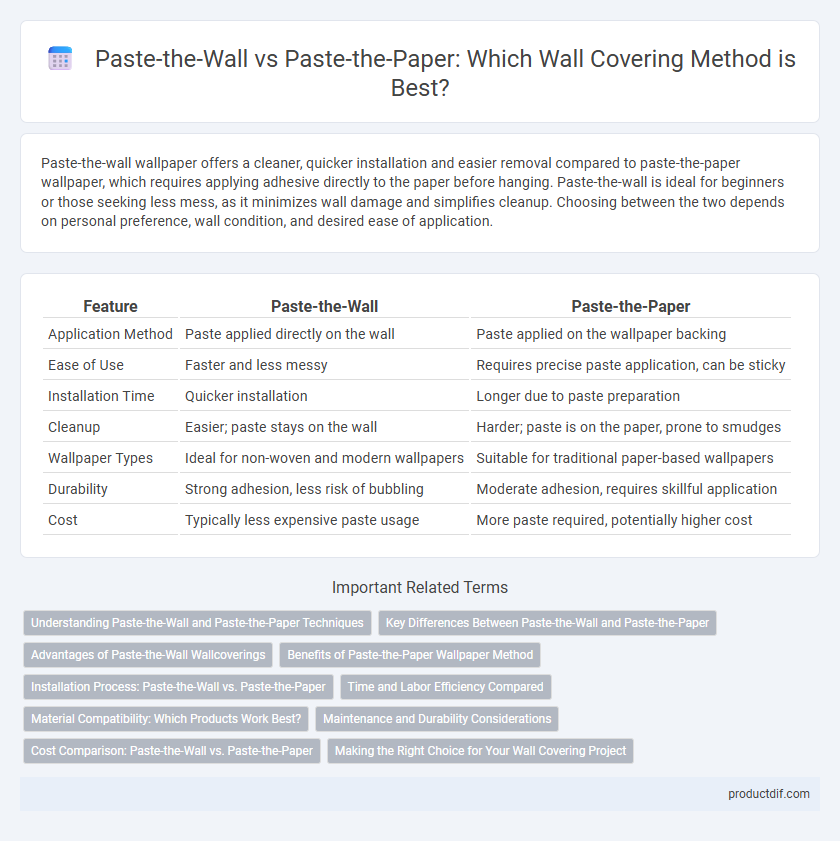Paste-the-wall wallpaper offers a cleaner, quicker installation and easier removal compared to paste-the-paper wallpaper, which requires applying adhesive directly to the paper before hanging. Paste-the-wall is ideal for beginners or those seeking less mess, as it minimizes wall damage and simplifies cleanup. Choosing between the two depends on personal preference, wall condition, and desired ease of application.
Table of Comparison
| Feature | Paste-the-Wall | Paste-the-Paper |
|---|---|---|
| Application Method | Paste applied directly on the wall | Paste applied on the wallpaper backing |
| Ease of Use | Faster and less messy | Requires precise paste application, can be sticky |
| Installation Time | Quicker installation | Longer due to paste preparation |
| Cleanup | Easier; paste stays on the wall | Harder; paste is on the paper, prone to smudges |
| Wallpaper Types | Ideal for non-woven and modern wallpapers | Suitable for traditional paper-based wallpapers |
| Durability | Strong adhesion, less risk of bubbling | Moderate adhesion, requires skillful application |
| Cost | Typically less expensive paste usage | More paste required, potentially higher cost |
Understanding Paste-the-Wall and Paste-the-Paper Techniques
Paste-the-wall and paste-the-paper represent two distinct wallpaper installation techniques that significantly affect project time and mess levels. Paste-the-wall involves applying adhesive directly to the wall, ideal for pre-pasted or lightweight wallpapers, enabling quicker hanging and easier adjustments. Paste-the-paper requires coating the wallpaper's back with paste, common for heavier or traditional wallpapers, ensuring stronger adhesion but demanding more drying time and careful handling.
Key Differences Between Paste-the-Wall and Paste-the-Paper
Paste-the-wall wallpaper requires adhesive applied directly to the wall, simplifying the installation process and reducing mess compared to paste-the-paper wallpaper, where paste is spread on the back of the paper before application. Paste-the-wall is often preferred for heavier or textured wallpapers because it provides better alignment and easier repositioning during installation. In contrast, paste-the-paper wallpaper demands more preparation and skill, making it less suitable for beginners or quick renovations.
Advantages of Paste-the-Wall Wallcoverings
Paste-the-wall wallcoverings offer the advantage of easier and cleaner installation, as adhesive is applied directly to the wall, reducing mess and drying time. This method allows for quicker repairs and repositioning, enhancing overall flexibility during application. The process is often preferred for its efficient handling of delicate or textured wallpapers, minimizing damage and ensuring a smooth finish.
Benefits of Paste-the-Paper Wallpaper Method
The paste-the-paper wallpaper method offers easier handling and less mess since adhesive is applied directly to the wallpaper rather than the wall, reducing drying time and minimizing wall damage. This technique enhances alignment accuracy and simplifies repositioning during installation, making it ideal for beginners and DIY projects. Paste-the-paper wallpapers often feature lighter weight materials, contributing to faster matching of patterns and a smoother overall finish.
Installation Process: Paste-the-Wall vs. Paste-the-Paper
Paste-the-wall wallpaper requires applying adhesive directly to the wall, allowing the paper to be hung without soaking, which speeds up installation and reduces mess. Paste-the-paper wallpaper needs adhesive applied to the back of the wallpaper, requiring soaking time and careful handling to prevent tearing or stretching. The paste-the-wall method is generally more user-friendly and preferred for quicker, cleaner installations, especially for DIY projects.
Time and Labor Efficiency Compared
Paste-the-wall wallpaper offers greater time and labor efficiency compared to paste-the-paper options, as the adhesive application is simplified and less messy, reducing preparation and cleanup time. This method allows for quicker installation, especially on large surface areas, by eliminating the need to paste each paper strip individually. Professional installers often prefer paste-the-wall products for faster turnaround times and streamlined workflows, enhancing overall productivity.
Material Compatibility: Which Products Work Best?
Paste-the-wall wallpaper adheres directly to most wall surfaces, making it ideal for uneven or textured walls and works best with vinyl, non-woven, and fabric-backed papers. Paste-the-paper requires applying adhesive to the wallpaper itself and is typically suited for traditional paper-based wallpapers that need more precise alignment and careful handling. Material compatibility favors paste-the-wall products for modern, durable wallpapers, while paste-the-paper remains preferred for delicate or lightweight decorative papers.
Maintenance and Durability Considerations
Paste-the-wall wallpaper simplifies maintenance by minimizing the risk of paper damage during application and reducing residual adhesives that attract dust and dirt. Paste-the-paper wallpaper offers traditional durability but requires careful handling to avoid tearing and may trap paste beneath the paper, leading to long-term adhesion problems. Choosing paste-the-wall enhances ease of cleaning and prolongs wall covering lifespan through reduced moisture and grime buildup.
Cost Comparison: Paste-the-Wall vs. Paste-the-Paper
Paste-the-wall wallpaper typically involves higher initial material costs due to specialized adhesives but reduces labor expenses since adhesive application is streamlined, leading to overall cost savings on large projects. Paste-the-paper wallpaper usually requires less expensive wallpaper paste but demands more labor, as the adhesive must be applied to each strip individually, increasing installation time and cost. Choosing between the two depends on balancing upfront adhesive prices against labor intensity, with paste-the-wall often favored for efficiency and cost-effectiveness in extensive wall coverings.
Making the Right Choice for Your Wall Covering Project
Paste-the-wall wallpaper offers quicker installation and less mess by applying adhesive directly to the wall, making it ideal for DIY projects and beginner users. Paste-the-paper requires coating the wallpaper itself with paste, which provides a more traditional method suited for intricate patterns or heavy, textured materials demanding precise adherence. Choosing between paste-the-wall and paste-the-paper depends on your project's complexity, wall condition, and personal comfort with wallpaper application techniques.
Paste-the-wall vs Paste-the-paper Infographic

 productdif.com
productdif.com